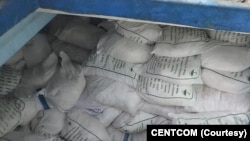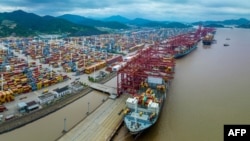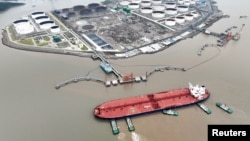The Trump administration has made its first comment on Western media reports that Iran is trying to ship a missile propellant ingredient from China, telling VOA it is aware of the reports published last month, while declining to confirm their veracity.
Responding to a VOA query about the purported Iranian scheme, a State Department spokesperson said in a Jan. 30 statement, “We are aware of the press reports. However, we do not comment on intelligence matters.”
Britain’s Financial Times and The Wall Street Journal in the United States published reports on Jan. 22 and 23 respectively, citing unnamed Western officials as saying Iran-flagged ships Golbon and Jairan were in the process of being loaded with 1,000 metric tons of sodium perchlorate near Ningbo on China’s eastern coast. The Financial Times described its sources as “security officials” in two Western countries, while The Wall Street Journal attributed the same information to a “Western official” and other “people familiar with the matter.”
The news outlets said the purported shipment could be transformed into enough ammonium perchlorate — a key solid fuel propellant component — to produce 260 midrange Iranian missiles.
Both the Golbon container ship and the Jairan cargo ship are sanctioned by the U.S. Treasury Department. The vessels’ appearance on the Office of Foreign Assets Control’s Specially Designated Nationals List means they are blocked from U.S.-related commerce.
In its statement, the State Department said the U.S. “remains focused on preventing the proliferation of items, equipment, and technology that could benefit Iran’s missile or other weapons programs and continues to hold Iran accountable through sanctions.”
A spokesman for Iran’s U.N. Mission in New York did not respond to a VOA request emailed on Friday to confirm whether Iran is using the Golbon and Jairan to ship sodium perchlorate from China, and whether Western media reports have prompted any changes to the alleged scheme.
Iran has a decades-old economic and military partnership with China, which was formalized in a 2021 cooperation agreement that called for more joint military exercises and weapon-systems development as both nations seek to counter what they see as U.S. global hegemony. But the two sides have not confirmed any Chinese weapons sales to Iran since the agreement’s signing.
Chinese Foreign Ministry spokeswoman Mao Ning responded to the Western media reports in a Jan. 23 press briefing, saying Beijing was unaware of the situation with the Iranian ships. She also asserted that Beijing always abides by its own export controls and international obligations and rejects other countries imposing what it considers to be illegal unilateral sanctions.
Ammonium perchlorate, for which sodium perchlorate is a precursor, is subject to export controls under the Missile Technology Control Regime, an informal association of 35 governments sharing common interests in the nonproliferation of missiles. Neither Iran nor China are members of the voluntary export-control organization, which includes mostly Western nations and their Asian allies, as well as Russia.
Iran makes its own chemicals for the production of solid fuel missile propellant, according to Behnam Ben Taleblu, a researcher at the Washington-based Foundation for Defense of Democracies. But he told VOA in an interview that after Israel destroyed much of Iran’s missile manufacturing in an aerial attack last October, Iranian military planners have an urgent need for backup supplies.
“It makes sense for Iran to try to obtain more of these precursor chemicals from China because Tehran sees Beijing as a more trusted partner than other nations,” Ben Taleblu said.
In another development, a joint review of ship tracking websites by VOA and Dubai-based intelligence analyst Martin Kelly of EOS Risk Group in recent days has uncovered new details of the movements and loading statuses of the Golbon and Jairan since Western media first reported their roles in the alleged Iranian import scheme.
The reviews of websites MarineTraffic and Lloyd’s List Intelligence’s Seasearcher show the Golbon had a draught change on Jan. 22 at sea near Zhoushan Island off the coast of Ningbo. The ship was noted sitting two meters deeper in the water, an indication that it was loaded with cargo in a ship-to-ship transfer from another vessel, Kelly said.
No cargo ship could be seen adjacent to the Golbon on that date on MarineTraffic. Vessels engaged in illicit ship-to-ship transfers often switch off their Automatic Identification System (AIS) transponders — devices that transmit positional and other data as part of an internationally mandated tracking system — to evade detection, as noted in a 2023 U.S. government advisory highlighting common tactics deployed by malign actors in the maritime industry.
After the Jan. 22 draught change, the Golbon headed north toward a stated destination of Taicang port near Shanghai on the same day, but it stopped short and remained stationary at sea for the next three days, according to MarineTraffic. On Jan. 25, the Golbon changed its stated destination and headed south toward southern China’s Zhuhai Gaolan Port.
The anonymous sources cited by the Financial Times on Jan. 22 said they expected the Golbon and the Jairan to deliver their purported cargos of sodium perchlorate straight to Iran on a three-week voyage without making any port calls.
But the Golbon arrived at Zhuhai Gaolan Port on Jan. 30 and remained there for two days before departing with another draught change, according to MarineTraffic. Upon departure, the Golbon was sitting several meters deeper in the water, indicating a further loading of cargo during the port call. It also reported a new destination of Iran’s Bandar Abbas port and an estimated arrival of Feb. 14.
As the Golbon had a draught change near Zhoushan Island on Jan. 22, the Jairan was docked at Liuheng Island, about 30 kilometers to the south.
The Financial Times cited its sources as saying the Jairan would depart for Iran with newly loaded cargo early this month. But the ship remained docked at Liuheng on Monday, sitting at the same depth in the water as when it was in the waters off southern China in November and heading north toward the Ningbo coast, according to Seasearcher. It was an indication that the Jairan has not been loaded with any significant cargo since November, Kelly said.
There was no word on which Chinese manufacturers may be involved in the purported scheme to supply the sodium perchlorate to Iran. The U.S. has long sanctioned Chinese companies for providing missile components to Iran, but a VOA search of U.S. government websites found no specific references to sanctions on Chinese manufacturers of sodium perchlorate.
The Treasury Department did not respond to a VOA inquiry, sent on Friday, regarding whether the U.S. has sanctioned Chinese makers of the chemical.
The U.S. sanctioned Iranian government defense company Parchin Chemical Industries in 2008 and its suspected agents in 2022 for procuring ballistic missile propellant-related materials from abroad for use by Iran’s top military force, the Islamic Revolutionary Guards Corps.









